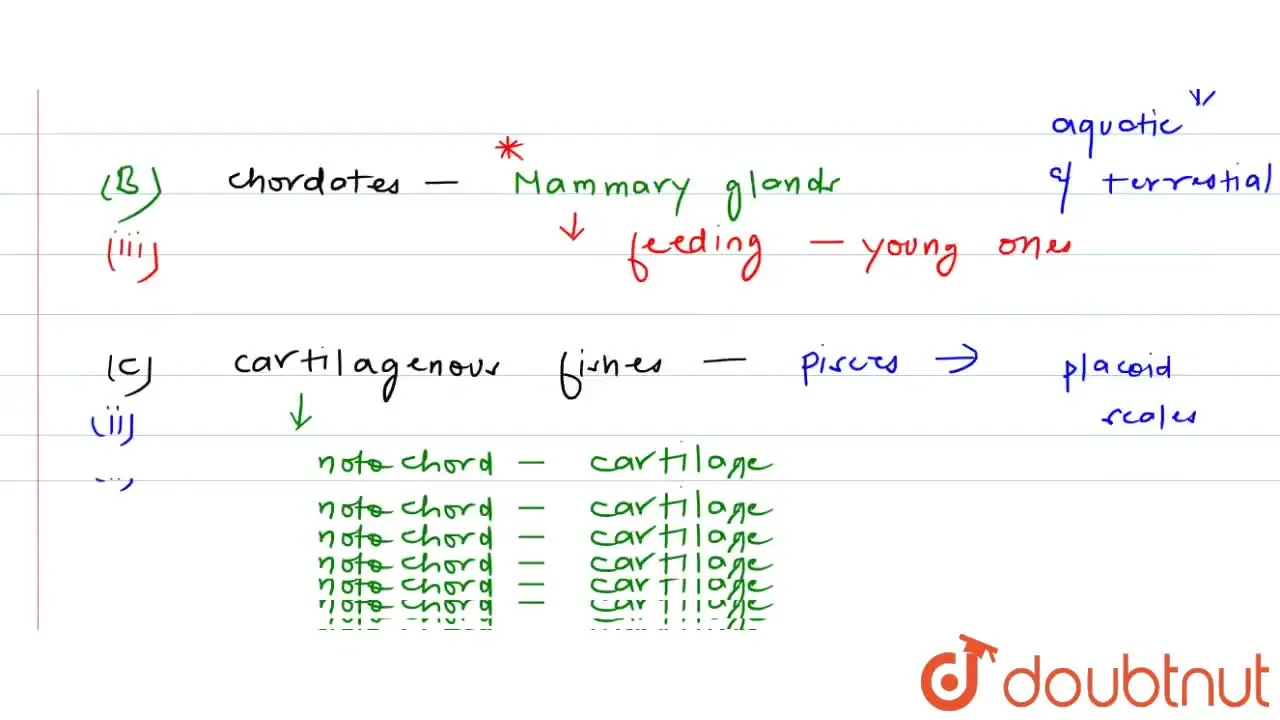Match the following
A.Amphibia(i)Air bladderB.Mammals(ii)Cartilaginous notochordC.Chondrichthyes(iii)Mammary glandsD.Osteichthyes(iv)Pneumatic bonesE.Cyclostomata(v)Dual habitatF.aves(vi)Sucking and circular mouth with out jaws.
A. → (v) B. → (iii) C. → (ii) D. → (i) E. → (vi) F. → (iv)
A. Amphibians possess dual habital, i.e., they are found in both aquatic and terrestrial habitat. Their larva is completely aquatic and adult lives in terrestrial as well as in aquatic habitat
B. Mammals have mammary glands which produce milk and feed their young ones. The mammary glands are enlarged exocrine modified sweet glands functional in female mammals.
C. Chondrichthyes have the cartilaginous rod (notochord) in the young stage which is gradually replaced by cartilage.
D. Osteichthyes have air bladder which is a vesicle or sac containing air,
E. Cyclostomes possess sucking and circular mouth without jaws which is surroundes by tentacles and the togue bears teeth. e.g., lamprey and nagfish.
F. Aves have light weighted bones with internal spacialised air sacs. These are the adaptations which enable birds to fly.
Related Playlists
- BOOK - NCERT EXEMPLARCHAPTER - ANIMAL KINGDOMEXERCISE - LONG ANSWER TYPE QUESTIONS4videos
ANIMAL KINGDOM
- BOOK - NCERT EXEMPLARCHAPTER - ANIMAL KINGDOMEXERCISE - VERY SHORT ANSWER TYPE QUESTIONS15videos
ANIMAL KINGDOM
- BOOK - NCERT EXEMPLARCHAPTER - ANATOMY OF FLOWERING PLANTSEXERCISE - Long Answer6videos
ANATOMY OF FLOWERING PLANTS
- BOOK - NCERT EXEMPLARCHAPTER - BIOLOGICAL CLASSIFICATIONEXERCISE - Long answer5videos
BIOLOGICAL CLASSIFICATION
Similar Questions
Match column I with column II and select the correct option form the given codes.
Column IColumn IIA.Amphibia(i)Air bladderB.Mammals(ii)Cartilaginous notochordC.Chondrichthyes(iii)Mammary glandsD.Osteichthyes(iv)Pneumatic bonesE.Cyclostomata(v)Dual habitatF.Aves(vi)Sucking and circular mouth without jawsView SolutionMatch the following columns
Column IColumn IIa.Lysozyme(i)HClb.Peptic cells(ii)Antibacterial enzymec.Saliva(iii)Sublingual glandd.Oxyntic cells(iv)PepsinogenView SolutionMatch the following Columns
Column IColumn IIA.Collateral and open(i)Cucubita stemB.Radial(ii)FernC.Bicollateral(iii)Maize rootD.Concentric(iv)Sunflower(v)Maize stemView SolutionMatch the following and choose the correct option.
A.Familyi.tuberosumB.Kingdomii.PolymonialesC.Orderiii.SolanumD.Speciesiv.PlantaeE.Genusv.SolanaceaeView SolutionMatch the following and write correct choice in space provided
AnimalCharacteristicsA.Pila(i)Jointed appendagesB.Cockroach(ii)PerchingC.Asterias(iii)Water vascular systemD.Torpedo(iv)Electric organE.Parrot(v)Presence of shellF.Dog fish(vi)Placoid scales
A........ B........
C........ D........
E........ F........View SolutionMatch the following
A.IAAi.Herring sperm DNAB.ABAii.BoltingC.Ethyleneiii.Stomatal closureD.GAiv.Weed-free lawnsE.Cytokininsv.Ripening of fruitsView SolutionMatch the following.
A.IAA(i)Hering spermDNAB.ABA(ii)BoltingC.Ethylene(iii)Stomatal closureD.GA(iv)Weed-free lawnsE.Cytokinins(v)Ripening of fruitsView SolutionExcretory organs of different animals are given below. Choose correctly and write in the space provided.
AnimalExcretory Organ/UnitA.Balanoglossus(i)MetanephridiaB.Leech(ii)NephridiaC.Locust(iii)Flame cellsD.Liver fluke(iv)AbsentE.Sea urchin(v)Malpighian tubuleF.Pila(vi)Proboscis glands
A........ B........
C........ D........
E........ F........View SolutionMatch the column I with column II
Column -IColumn-IIa.Horizontal and amacrine cell(i)Pivot pointb.Incus(ii)Olfactory epitheliumc.Bowman's gland(iii)Retinad.Cupula(iv)Crista(v)MaculaView SolutionMatch the Colum-I with Column -II . Column-IColumn-II(A)Fish(i)3-chambered heart (B)Amphibia(ii)Incomplete double circulation(C)Birds(iii)4-chmabered heart(iv)Single circulation(v)2-chambered heart(vi)Double circulation
View Solution


